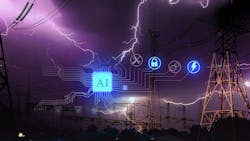When artificial intelligence makes headlines, the story often focuses on the strain AI data centers put on the grid. These facilities already consume enormous amounts of electricity and are projected to increase significantly in the coming years, potentially overwhelming our aging power grid. That concern is valid, making grid modernization and expansion crucial.
Recently, several articles have acknowledged the strain, but at the same time, they praise AI as the solution rather than just adding to the grid’s problems. A recent piece in Fortune, “AI is the grid’s turning point—and its salvation,” reflected this growing view. The framing is generally correct but incomplete. AI is effective at analyzing data and generating insights. Still, without physical grid devices that can act on that intelligence, the grid will remain vulnerable and underutilized to its full potential.
From Burden to Benefit
AI is not new to the energy management field. It has long been utilized by grid operators for load forecasting, enabling the balancing of supply and demand. What’s different now is the enhancement of existing applications, such as advanced forecasting models, predictive maintenance, and grid optimization, along with the emergence of new ones for cybersecurity and wildfire risk assessments. This is changing how we manage grid infrastructure. AI can support current planning, operation, and maintenance tasks, and it can also address new challenges where no solutions previously existed. All of this is achieved by providing insights through software and tools that better inform human decisions or automate the decision-making process entirely.
California offers a strong example. As MIT Technology Review reported, CAISO now uses AI to manage its high-voltage system to reduce blackout risk. These tools predict equipment failures, evaluate wildfire risk in real time, and allow operators to reroute power before outages happen.
However, as the Fortune article points out, 70% of America’s grid is outdated, with transformers and power lines that are over 25 years old—or possibly even older. AI, while useful, won’t modernize the infrastructure by itself. The real breakthrough happens when AI combines with advanced field device technologies. For example, automated devices in the field that detect faults, isolate issues, and restore service within seconds—often before operators need to intervene. These devices can operate independently using local intelligence or be part of a larger system where their actions are guided by insights and decisions made at a more centralized location.
Where AI will make the Difference
The grid is an interconnected system—generation, transmission, and distribution—that must stay in balance as load changes, weather, and aging infrastructure present additional challenges. In addition, each part of the system has functional areas of planning, operation, and maintenance. In every segment and across all functions, increasing amounts of data are collected and insights generated, but for the most part, they are kept within each segment and function silo. AI can help unlock more value from each segment’s data by working across functions and segments. The following offers a sample of the areas AI can help improve.
- Planning: More accurate demand forecasts and streamlining the interconnection process for new generation sources and large-scale loads—such as AI data centers. By automating complex studies and accelerating approvals, AI enables utilities to integrate new assets more efficiently, thereby reducing bottlenecks and ensuring resources are available as demand increases.
- Operations: Enhanced situational awareness through real-time measurements, digital twins of the grid and its devices, and quicker outage response. In California, field-deployed cameras combined with AI detect fires before 911 calls are logged one-third of the time.
- Maintenance: Transitioning from a run-to-failure or preventive maintenance approach to a predictive one can be supported by using AI-driven analytics that leverage data, digital twins, and drones to assess risks and act before failures happen.
Challenges to Navigate
AI’s potential is vast, but challenges still exist, such as questionable data quality, legacy systems that make it difficult to extract information from the data, and the “black box” nature of AI models, which makes trust difficult in mission-critical applications.
But momentum on adopting AI is increasing. In wildfire management, predictive maintenance, and interconnection studies, AI is already proving its value. Over the next decade, it will shift from a supporting role to a central capability.
However, the action component of automation, along with field intelligence, is crucial. When updating the grid, quick improvements can be achieved with smart, action-enabled devices like smart reclosers, fault interrupters, and automated restoration systems on the distribution network. As severe weather occurs more often, long-term resilience depends on AI not only in the cloud but also on better algorithms within grid devices that help supply power to customers.
Every minute of downtime results in economic, safety, and environmental costs. AI can help, but with today’s unpredictable weather and demand spikes, it’s clear: AI without action isn’t enough.
A modernized grid demands more than just data and analytics innovation — it requires intelligence to predict issues, as well as equipment and a crew capable of responding and interacting with the physical grid when and where needed. That means AI that supports planning, prediction, and design; AI that actively identifies and resolves issues in software and tools; and smart field devices that take decisive actions.
The question isn’t whether AI will help save America’s aging grid. It’s how quickly we can scale these updated and new applications, coupled with intelligent physical devices, and extend them from control rooms into the field, all the way to the last mile.
About the Author
Ernst Scholtz
Ernst Scholtz is Chief Technology Officer of S&C Electric Company.
